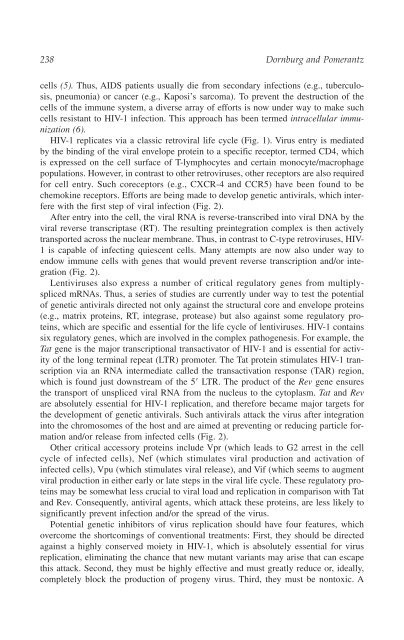Immunotherapy for Infectious Diseases
Immunotherapy for Infectious Diseases
Immunotherapy for Infectious Diseases
You also want an ePaper? Increase the reach of your titles
YUMPU automatically turns print PDFs into web optimized ePapers that Google loves.
238 Dornburg and Pomerantz<br />
cells (5). Thus, AIDS patients usually die from secondary infections (e.g., tuberculosis,<br />
pneumonia) or cancer (e.g., Kaposi’s sarcoma). To prevent the destruction of the<br />
cells of the immune system, a diverse array of ef<strong>for</strong>ts is now under way to make such<br />
cells resistant to HIV-1 infection. This approach has been termed intracellular immunization<br />
(6).<br />
HIV-1 replicates via a classic retroviral life cycle (Fig. 1). Virus entry is mediated<br />
by the binding of the viral envelope protein to a specific receptor, termed CD4, which<br />
is expressed on the cell surface of T-lymphocytes and certain monocyte/macrophage<br />
populations. However, in contrast to other retroviruses, other receptors are also required<br />
<strong>for</strong> cell entry. Such coreceptors (e.g., CXCR-4 and CCR5) have been found to be<br />
chemokine receptors. Ef<strong>for</strong>ts are being made to develop genetic antivirals, which interfere<br />
with the first step of viral infection (Fig. 2).<br />
After entry into the cell, the viral RNA is reverse-transcribed into viral DNA by the<br />
viral reverse transcriptase (RT). The resulting preintegration complex is then actively<br />
transported across the nuclear membrane. Thus, in contrast to C-type retroviruses, HIV-<br />
1 is capable of infecting quiescent cells. Many attempts are now also under way to<br />
endow immune cells with genes that would prevent reverse transcription and/or integration<br />
(Fig. 2).<br />
Lentiviruses also express a number of critical regulatory genes from multiplyspliced<br />
mRNAs. Thus, a series of studies are currently under way to test the potential<br />
of genetic antivirals directed not only against the structural core and envelope proteins<br />
(e.g., matrix proteins, RT, integrase, protease) but also against some regulatory proteins,<br />
which are specific and essential <strong>for</strong> the life cycle of lentiviruses. HIV-1 contains<br />
six regulatory genes, which are involved in the complex pathogenesis. For example, the<br />
Tat gene is the major transcriptional transactivator of HIV-1 and is essential <strong>for</strong> activity<br />
of the long terminal repeat (LTR) promoter. The Tat protein stimulates HIV-1 transcription<br />
via an RNA intermediate called the transactivation response (TAR) region,<br />
which is found just downstream of the 5� LTR. The product of the Rev gene ensures<br />
the transport of unspliced viral RNA from the nucleus to the cytoplasm. Tat and Rev<br />
are absolutely essential <strong>for</strong> HIV-1 replication, and there<strong>for</strong>e became major targets <strong>for</strong><br />
the development of genetic antivirals. Such antivirals attack the virus after integration<br />
into the chromosomes of the host and are aimed at preventing or reducing particle <strong>for</strong>mation<br />
and/or release from infected cells (Fig. 2).<br />
Other critical accessory proteins include Vpr (which leads to G2 arrest in the cell<br />
cycle of infected cells), Nef (which stimulates viral production and activation of<br />
infected cells), Vpu (which stimulates viral release), and Vif (which seems to augment<br />
viral production in either early or late steps in the viral life cycle. These regulatory proteins<br />
may be somewhat less crucial to viral load and replication in comparison with Tat<br />
and Rev. Consequently, antiviral agents, which attack these proteins, are less likely to<br />
significantly prevent infection and/or the spread of the virus.<br />
Potential genetic inhibitors of virus replication should have four features, which<br />
overcome the shortcomings of conventional treatments: First, they should be directed<br />
against a highly conserved moiety in HIV-1, which is absolutely essential <strong>for</strong> virus<br />
replication, eliminating the chance that new mutant variants may arise that can escape<br />
this attack. Second, they must be highly effective and must greatly reduce or, ideally,<br />
completely block the production of progeny virus. Third, they must be nontoxic. A


